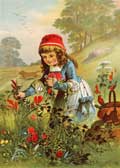 Little Red
Riding Hood
Little Red
Riding Hood
"Little Red Riding Hood" is a famous fairy tale about a young girl's encounter with a wolf. The story has been changed considerably in its history and subject to numerous modern adaptations and readings.
| Chinese | 小紅帽 |
| Italian | Cappuccetto Rosso |
| Spanish | Caperucita Roja |
The version most widely known today is based on the Brothers Grimm variant. It is about a girl called Little Red Riding Hood, after the red hooded cape or cloak she wears. The girl walks through the woods to deliver food to her sick grandmother.
A wolf wants to eat the girl but is afraid to do so in public. He approaches the girl, and she naïvely tells him where she is going. He suggests the girl pick some flowers, which she does. In the meantime, he goes to the grandmother's house and gains entry by pretending to be the girl. He swallows the grandmother whole, and waits for the girl, disguised as the grandmother.
When the girl arrives, she notices he looks very strange to be her grandma. In most
retellings, this eventually culminates with Little Red Riding Hood saying, "My,
what big teeth you have!"
To which the wolf replies, "The better to eat you with," and swallows
her whole, too.
A hunter, however, comes to the rescue and cuts the wolf open. Little Red Riding Hood and her grandmother emerge unharmed. They fill the wolf's body with heavy stones, which drown him when he falls into a well. Other versions of the story have had the grandmother shut in the closet instead of eaten, and some have Little Red Riding Hood saved by the hunter as the wolf advances on her rather than after she is eaten.
The tale makes the clearest contrast between the safe world of the village and the dangers of the forest, conventional antitheses that are essentially medieval, though no written versions are as old as that.